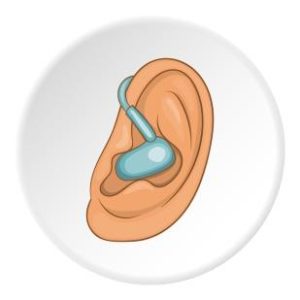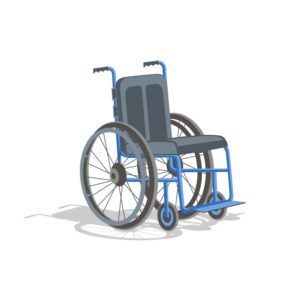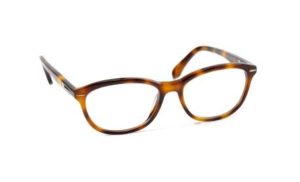This lesson focuses on the engineering of adaptive or assistive devices, such as prosthetic devices, wheelchairs, eyeglasses, grab bars, hearing aids, lifts, braces, etc. Students work in teams to design either an improvement to an existing adaptive device or a new device that solves a specific problem.
- Learn about adaptive devices.
- Learn about how ongoing changes to adaptive devices have impacted everyday life.
- Learn about teamwork and the engineering problem solving/design process.
Age Levels: 8-18
Materials & Preparation
Build Materials (For each team)
Required Materials
- One pair of eyeglasses or sunglasses (either old or inexpensive new)
- Eyeglass Repair Kit (including mini screwdriver, replacement screws, and if possible a magnifying glass)
Engineering Design Challenge
Design Challenge
You are a team of engineers given the challenge of learning about adaptive devices. You will first disassemble and reassemble a pair of eyeglasses or sunglasses to gain a better understanding of the materials and design. Then, you will design an improvement to an existing adaptive device or design a new device to solve a problem faced by people (or animals) and present it to the class.
Criteria
- Work as a team to Identify a physical challenge which your design will help to alleviate.
- Present your design to the class:
- Describe how your device works, technically, in words…include the materials you think it would be made from and what you think the product might cost.
- Show a sketch of either your final design, or a situation where it is being used.
- Describe how your team believes that engineers have impacted the world.
Constraints
Use only the materials provided.
Activity Instructions & Procedures
- Break class into teams of 3-4.
- Hand out the Adaptive Device Design worksheet, as well as some sheets of paper for sketching designs.
- Discuss the topics in the Background Concepts Section. Consider asking students what an adaptive device is.
- Review the Engineering Design Process, Design Challenge, Criteria, Constraints and Materials.
- Provide each team with their materials.
- Explain that students will be completing tasks on the student worksheets.
- Ask students to complete the first student worksheets by discussing the products shown on the sheet, determining whether the product is an adaptive device and what the engineers goal was.
- Ask students to complete the second worksheet by disassembling and reassembling an old pair of eyeglasses or sunglasses to evaluate the materials and design.
- Ask students to complete the third worksheet by working as a team to design an improvement to an existing adaptive device or to design a new device that solves a problem for people (or animals). They should:
- Identify a physical challenge which their device will help to alleviate (for example, a dog that has undergone back surgery still needs to be able to go for a walk).
- Sketch the new adaptive device or improved device.
- Present their ideas to the class in three forms:
- Describe how their device works, technically, in words…include the materials they think it would be made from and what they think the product might cost.
- Show a sketch of either their final design, or a situation where it is being used.
- Describe how the team believes that engineers have impacted the world.
- As a class, discuss the student reflection questions.
- For more content on the topic, see the “Digging Deeper” section.
Student Reflection (engineering notebook)
Step 1 – Disassembly:
- How many component parts did you find?
- What different types of materials (plastics, metals, glass) were part of the final pair of glasses?
- If you were reengineering these glasses to make them safer, would you change the shape of any of the component parts? Why? Why not?
- If you were reengineering these glasses to make them safer, would you change the materials used to manufacture any of the component parts? Why? Why not?
- What was the hardest part of the reassembly process? Why?
Step 2 – Reassembly
- Do you think that assembly would be easier managed by a machine? Why? Why not?
- How hard do you think it would be for a person with arthritis in their hands to reassemble their glasses?
Time Modification
The lesson can be done in as little as 1 class period for older students. However, to help students from feeling rushed and to ensure student success (especially for younger students), split the lesson into two periods giving students more time to brainstorm, test ideas and finalize their design. Conduct the testing and debrief in the next class period.
Engineering Design Process
Background Concepts

Ylivdesign-bigstock.com
Who Needs Adaptive Devices?
Adaptive or assistive devices are developed to assist individuals with a wide range of disabilities to improve their ability to live healthy and independent. It is estimated that 54 million Americans have some degree of disability. As defined by the U.S. Survey of Income and Program Participation, individuals 15 years old and over were identified as having a disability if they met any one of the following criteria:
- Used a wheelchair, a cane, crutches, or a walker
- Had difficulty performing one or more functional activities (seeing, hearing, speaking, lifting/carrying, using stairs, walking, or grasping small objects)
- Had difficulty with one or more activities of daily living. (ADLs include getting around inside the home, getting in or out of bed or a chair, bathing, dressing, eating, and toileting.)
- Had difficulty with one or more instrumental activities of daily living. (The IADLs included going outside the home, keeping track of money and bills, preparing meals, doing light housework, taking prescription medicines in the right amount at the right time, and using the telephone.)
- Had one or more specified conditions (a learning disability, mental retardation or another developmental disability, Alzheimer’s disease, or some other type of mental or emotional condition)
- Had a mental/emotional condition that seriously interfered with everyday activities
- Had a condition that limited the ability to work around the house
- If age 16 to 67, had a condition that made it difficult to work at a job or business
- Received U.S. federal benefits based on an inability to work
According to recent statistics for the United States:
- 25 million had difficulty walking a quarter mile or climbing a flight of 10 stairs, or used an ambulatory aid, such as a wheelchair (2.2 million) or a cane, crutches or a walker (6.4 million).
- About 18 million had difficulty lifting and carrying a 10-pound bag of groceries or grasping small objects.
- About 14.3 million had a mental disability, including 1.9 million with Alzheimer’s disease, senility or dementia; and 3.5 million with learning disabilities.
- About 8.0 million had difficulty hearing what was said in a normal conversation with another person (even when wearing a hearing aid).
- About 7.7 million had difficulty seeing the words and letters in ordinary newspaper print (even with glasses); of these, 1.8 million were unable to see words and letters in ordinary newspaper print.
Wheelchair Design Considerations

Roman79-bigstock.com
Wheelchair History
Greek vases from 530 BC show wheels incorporated into furniture. And, in 535 AD an engraving shows a wheelchair, and King Phillip II of Spain had a wheelchair in 1595 — so the need to use wheels to ease motion goes back a long way.
What’s New?
More recently, materials such as titanium have been used to improve the weight and maneuverability of wheelchairs. And, as wheelchair sports have become popular, engineers had to design additional features and capabilities into sport wheelchairs to meet the need of users who rely on the chair for speed and accurate movements.

Nikolayev-bigstock.com
Material/Design Tradeoffs
Engineers have to weigh different considerations when designing a wheelchair. For example, they know that titanium is the best material in terms of strength to weight ratios — but it is an extremely expensive material. On the other hand, carbon fiber is less expensive and durable. Different customers may prefer different materials. Engineers might seek to develop the most lightweight wheelchair — a lighter chair would potentially reduce the amount of wrist injuries because the customer would have a lighter chair to maneuver. And, engineers might have to consider the type of tires that made the most sense for a wheelchair. Also, the braking system is important — how easy is it for someone with decreased mobility to use the brakes? What type of motor would work best for a motorized chair — how fast is too fast? Will a new wheelchair design fit on standard wheelchair ramps? Engineers would have to completely redesign a wheelchair for use by children who may have different needs and braking abilities than adults. And, cost is always a big consideration — if engineers design the best wheelchair, but it costs more than most people could afford, the product will fail.
Research
In developing new designs, engineers might also conduct user surveys to find out what type of chair is most comfortable, most easy to move, most easy to brake. In addition, studies are done to determine the amount of oxygen a customer uses to move a chair, as an indication of how much energy is expended in making the chair move forward. Some motorized wheelchairs move so fast that crash testing is done to determine how the chair would protect a customer in the event of a crash.
Vocabulary
- Adaptive or assistive device: Developed to assist individuals with a wide range of disabilities to improve their ability to live healthy and independent.
- Constraints: Limitations with material, time, size of team, etc.
- Criteria: Conditions that the design must satisfy like its overall size, etc.
- Disassemble: Take something apart.
- Engineers: Inventors and problem-solvers of the world. Twenty-five major specialties are recognized in engineering (see infographic).
- Engineering Design Process: Process engineers use to solve problems.
- Engineering Habits of Mind (EHM): Six unique ways that engineers think.
- Iteration: Test & redesign is one iteration. Repeat (multiple iterations).
- Prosthetic Device: Device designed to replace a missing part of the body or to make a part of the body work better.
- Prototype: A working model of the solution to be tested.
- Reassemble: To put the parts of something back together.
Dig Deeper
Internet Connections
Recommended Reading
- The Design of Everyday Things by Donald A. Norman (ISBN: 978-0465050659)
- Product Design And Development by Ulrich Eppinger (ISBN: 978-9352601851)
Writing Activity
Write an essay or a paragraph describing which adaptive device you think has most dramatically impacted the world. Give supporting details, and offer suggestions for further improvements to this device.
Curriculum Alignment
Alignment to Curriculum Frameworks
Note: All Lesson Plans in this series are aligned to the U.S. National Science Education Standards (produced by the National Research Council and endorsed by the National Science Teachers Association), and if applicable, to the International Technology Education Association’s Standards for Technological Literacy and the National Council of Teachers of Mathematics’ Principles and Standards for School Mathematics.
National Science Education Standards Grades K-4 (ages 4-9)
CONTENT STANDARD E: Science and Technology
As a result of activities in grades 5-8, all students should develop
- Abilities of technological design
- Understandings about science and technology
CONTENT STANDARD F: Science in Personal and Social Perspectives
As a result of activities, all students should develop understanding of
- Risks and benefits
- Science and technology in society
CONTENT STANDARD G: History and Nature of Science
As a result of activities, all students should develop understanding of
- Science as a human endeavor
National Science Education Standards Grades 5-8 (ages 10-14)
CONTENT STANDARD E: Science and Technology
As a result of activities in grades 5-8, all students should develop
- Abilities of technological design
- Understandings about science and technology
CONTENT STANDARD F: Science in Personal and Social Perspectives
As a result of activities, all students should develop understanding of
- Personal health
- Risks and benefits
- Science and technology in society
CONTENT STANDARD G: History and Nature of Science
As a result of activities, all students should develop understanding of
- Nature of science
- History of science
National Science Education Standards Grades 9-12 (ages 14-18)
CONTENT STANDARD E: Science and Technology
As a result of activities, all students should develop
- Abilities of technological design
- Understandings about science and technology
CONTENT STANDARD F: Science in Personal and Social Perspectives
As a result of activities, all students should develop understanding of
- Personal and community health
- Science and technology in local, national, and global challenges
CONTENT STANDARD G: History and Nature of Science
As a result of activities, all students should develop understanding of
- Historical perspectives
Standards for Technological Literacy – All Ages
The Nature of Technology
- Standard 1: Students will develop an understanding of the characteristics and scope of technology.
- Standard 3: Students will develop an understanding of the relationships among technologies and the connections between technology and other fields of study.
Technology and Society
- Standard 4: Students will develop an understanding of the cultural, social, economic, and political effects of technology.
- Standard 6: Students will develop an understanding of the role of society in the development and use of technology.
- Standard 7: Students will develop an understanding of the influence of technology on history.
Design
- Standard 10: Students will develop an understanding of the role of troubleshooting, research and development, invention and innovation, and experimentation in problem solving.
Abilities for a Technological World
- Standard 13: Students will develop abilities to assess the impact of products and systems.
The Designed World
- Standard 17: Students will develop an understanding of and be able to select and use information and communication technologies.
Related Engineering Fields and Degrees
Student Worksheet
As a team, complete the following worksheet, indicating which of the products below would be considered “adaptive devices.”
Product Adaptive? Yes or No Why or Why Not What Was the Engineers Goal? Eyeglasses Platforms Baby Stroller
Watch that Speaks the Time
Walker Headphones Cast
Component PartsStep One: As a team, disassemble a pair of old, unusable sunglasses or glasses, using an eyeglass repair kit provided to you.
Questions:
- How many component parts did you find?
- What different types of materials (plastics, metals, glass) were part of the final pair of glasses?
- If you were reengineering these glasses to make them safer, would you change the shape of any of the component parts? Why? Why not?
- If you were reengineering these glasses to make them safer, would you change the materials used to manufacture any of the component parts? Why? Why not?
Step Two: Reassemble the glasses.
Questions:
- What was the hardest part of the reassembly process? Why?
- Do you think that assembly would be easier managed by a machine? Why? Why not?
- How hard do you think it would be for a person with arthritis in their hands to reassemble their glasses?

big8183-bigstock.com
Throughout history, engineers have solved problems by developing products and systems to help people. In the area of adaptive engineering design, the goal is to create products that make life easier, healthier, and more independent for those who face challenges. The following is just a short list of the many devices that have been designed to help people and animals:
- wheelchairs
- walkers
- eyeglasses
- adaptive gardening tools
- hearing aids
- adaptive canoe seats
- replacement joints
- artificial limbs
- adaptive water-skis
- dressing aids
- safety bars for tubs
- adaptive fitness equipment
- shower chairs
- jar opening tools
- specialty computer mouse
- sleep apnea mask
- adaptive golf clubs
- steering wheels
- adaptive tricycles
- lifts for horses
- crutches
- playing card holders
- bedrails
- illuminated magnifiers
- oversized lamp switches
- adaptive video game joysticks
You are the Engineering Team!
Your challenge is to work as a team to either improve an existing adaptive product or come up with a new one that solves a specific problem faced by individuals (or animals) who face physical challenges.
State the Problems:
- Identify a physical challenge which your product will help to alleviate (for example, a dog that has undergone back surgery still needs to be able to go for a walk).
- As a team, develop on paper a new product or develop an improvement to an existing product that meet the need of the person/animal.
- Present your ideas to the class in three forms:
- describe how your product works, technically, in words…include the materials you think it would be made from, and what you think the product might cost.
- draw an illustration of either your final product, or a situation where it is being used.
- describe how your team believes that engineers have impacted the world.
Translations





 Industrial Engineering
Industrial Engineering
 Computer Engineering
Computer Engineering